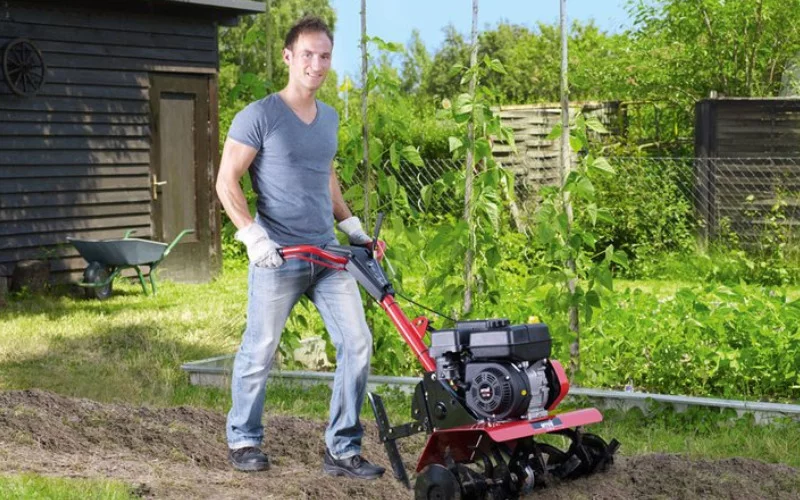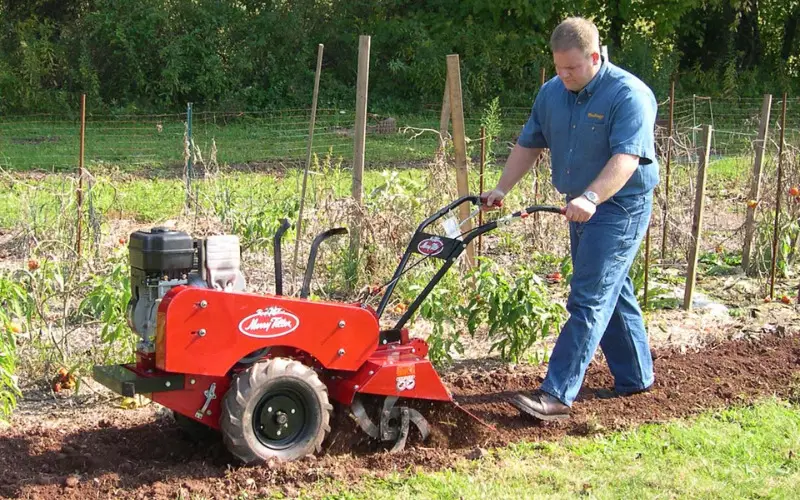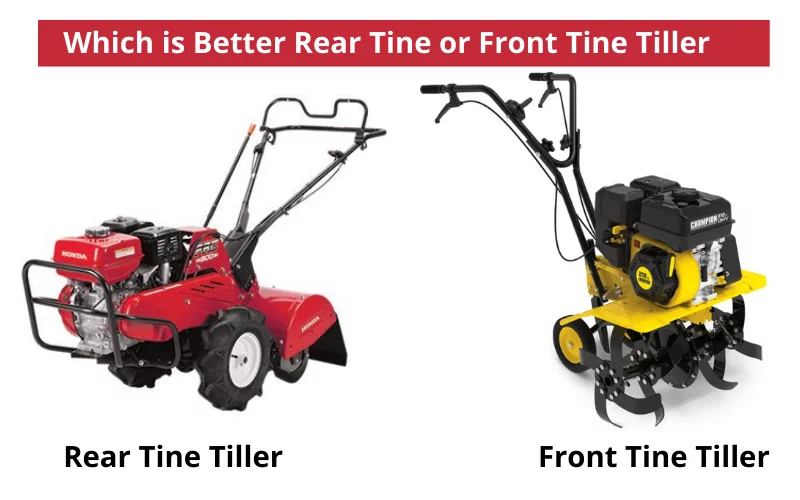A tiller is a piece of agricultural equipment used to mix broken-up soil. It is very helpful at the start of a farming season and good for the soil.
If you are considering purchasing or renting a tiller, you are probably looking at the two types of tillers, the rear-tine and the front-tine, but which is better?
They both have their strengths and weaknesses and can perform differently when tasked with various operations, but this guide reveals all the information you need to know about these tillers.
How Does a Tiller Work?
Tillers are farm equipment with teeth that are curved at the tip; this helps them dig deeper into the soil and turn it around.
A driver controls the tiller, and it moves on wheels. You can get a basic or advanced tiller for more complex tasks.
Although this equipment is used for basically the same operation, creating a better soil texture for planting, there is a prominent difference in how the different types of tillers do this work.
Front Tiller Overview

The major feature of a front tine tiller is that they are smaller in size and easy o handle, and they have their tines in the front. Here is an overview of its features.
1. Tine Placement
As we have mentioned, the tine in his type of tiller is placed directly at the front. You can see that it is placed just below the engine and close to the wheels.
2. Tine Rotation
The tines or teeth of the tiller rotate to loosen and mix up the soil well, allowing them to do a neat and effective job.
Their working mechanism involves digging into the ground and pulling the soil free. In the case of the front tine tiller, since it is automatically powered, you don’t have to follow it around but direct it towards the right path. It may not perform very well on very compacted soil.
3. Tilling Capability
The tines of this tiller can dig as far as 6 to 8 inches and cover a width between 12 to 22 inches. While tilling, it may encounter problems with roots and weeds if the equipment you are using is gas-powered.
An electric-powered front tine has no problem tearing through shallow roots, grass, or weeds. This is because gas tillers work based on horsepower while electric ones don’t, but some good models will be capable of this.
Because of their relatively small size, front tine tillers tend to bounce or buck when encountered with some obstacles, so if your land has stones, it may be difficult for them to work.
This becomes a safety problem if they encounter too many stones. We recommend that you remove the stones before firing up this machine.
Front tine tillers can be powered by electricity or gas. Electric tillers are great for working on a small space of about 5oo square feet, but they have a great performing power. They are lightweight and available in corded or battery-powered models.
Gas tillers are more powerful than electric ones making them great for a larger space of about 5000 square feet as they are designed for more tedious work.
The only downside of a gas tiller is that they are heavier than the electric ones. Most gas-powered tillers are available with engines ranging between 32cc and 208cc, yielding a horsepower of about 4 to 6.
4. Where To Use a Front Tine Tiller
Front tine tillers are lightweight and not suitable to be used on very tough soil; they should be used on small tight spaces with soil that has been previously worked on. This is because while some are made for intense work, it will take a little more effort to get the job done.
You should get a front tine tiller if you have a small space close to your home for vegetables or a flower garden. Thanks to their lightweight nature, they are easy to control around your yard, allowing you to control the machine’s work quality.
If you need to work on tougher soil, you should invest in a gas-powered tiller as they can handle a more intense soil.
Pros of a Front Tine Tiller
- Great for a small space like a small garden
- Available in both gas and electric models
- Good for shallow roots and grasses
- Works greatly on the soil to produce a fine texture
- Easy to move around
- Affordable
- The small size makes it easy to store
Cons of a Front Tine Tiller
- Cannot work in a large area
- The soil will need to be worked on initially before this machine can be used
- Can cut through thick root with a diameter of ½ inches
- It can be not easy to control
Rear Tine Tiller Overview

It’s obvious from the name that this tiller has its tine attached to the rear of the equipment. Below are the details of this type of tiller.
1. Tine Placement
The tines go behind the wheels and engine. Going deeper, we will discuss the advantages of this placement.
2. Tine Rotation
The rotation of the tines on this tiller is a bit different from the previous. It has a counter-rotation system, which means it moves in the opposite direction of the tires.
If the wheels of the machine are moving forward, then the tines will be moving backward. This movement pattern allows the teeth to dig and loosen up the soil more to create neat and organized lines and a nice texture.
Some rear tine tillers offer a dual function where you can choose two different functions. For example, if the wheels rotate forward and the tines backward, this motion can be switched where the tines will go forward and the wheels backward. However, this dual tiller is more expensive than the regular rear tine tillers.
3. Tilling capability
The rear tine tiller has between 4 to 10 tines, depending on the brand or model you purchase. They dig at a depth between 6 to 14 inches and a width of 12 to 24 inches. Like the number of tines, these factors also depend on the brand or model you purchased.
Unlike the front tine tillers, this machine can handle stones and thick roots of about an inch in diameter without being affected.
This is because of their large engine size that provides between 8 to 10 horsepower, and even with a lesser horsepower, they can cut through a reduced amount of roots and handleless stone.
The counter-rotating feature allows it to uncover stones, but if the stones get tangled in the tines, it could disrupt the machine’s work and even be a safety risk for you controlling it.
Before using this tiller, try removing as many stones as possible to prevent these occurrences. Most rear tines use gas as a power source and have an engine size between 99cc and 350cc.
4. Where To Use a Rear Tine Tiller
Rear tine tillers are built for more intense and large-scale jobs as they have more power and can dig deeper. The engine powers the wheels, so it is easier to move this tiller around than a front tine tiller; this quality also makes it best for larger tasks.
They can cover 5000 square feet or more, and they are great for compacted stones with thick roots, grasses, and some stones. This is why farmers who own large farmland choose to invest in a rear tine tiller.
Pros of rear tine tiller
- Covers a large space
- Suitable for hard soil with thick roots and stones
- Self-propelled
- Had a wider range of tilling, which gets more work done in a short time
- Dual-rotation
- Easy to maneuver
Cons of rear tine tiller
- Large
- Difficult to store
- Expensive
- In small spaces, it can be difficult to control
Which is Better Rear Tine or Front Tine Tiller?
The type of tiller ideal for you depends on the type of task at hand. As we have discussed above, if you have a large piece of land with really hard soil with thick roots and stones, you should invest in a rear tine tiller. But if you have a small space with shallow roots, a front tine tiller should do just fine.
Your budget also contributes greatly. If you do not have enough money for a rear tiller, get a front tine tiller to use.
But if you own huge farmland, you need a rear tine tiller. When choosing the right type of tiller, you should rely on the following facts.
- Size of farmland
- Budget
- Texture of soil
- Storage space
- Ease of control
Conclusion
Before creating mini farmland or huge farmland, you must gather all the necessary equipment. But when it comes to choosing a tiller, you may be confused about which to choose. The rear tine tiller is best for large farmlands, while the front tine tiller is suitable for small spaces.
The tiller you choose depends on the nature of the work being done, and the rear tiller has an advantage over the front tiller when it comes to compacted soil and working for a long time. We also discussed various power sources of a front tine tiller, including electric and gas-powered tillers.
Helpful Articles:
- Can A Leaf Blower Be Used as A Snow Blower?
- How to Adjust Snowblower Skids for Gravel Driveway
- Ryobi Snow Blower vs Ego Snow Blower Reviews
- Factors to Consider When Buying a Snowblower for Gravel Driveway
We trust this article helped you determine which is better between Rear Tine and Front Tine Tiller. You may also want to check out The Best Lightweight Lawnmower.
Thanks for taking the time to read our article, and we hope you find it helpful. Would you mind leaving a comment below if you have any suggestions?
Kindly reach out to people by sharing this post on social media.
If you liked this article, then please follow us on Facebook, Instagram, and Pinterest.


